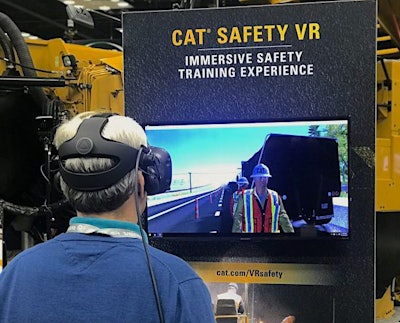
 Cat introduced its first foray into virtual-reality safety training at the 2019 World of Asphalt. On the screen above, a foreman gives instructions to the headset wearer, who undergoes simulated scenarios a new worker on a highway paving crew would face. Photo credit: Michael Newman
Cat introduced its first foray into virtual-reality safety training at the 2019 World of Asphalt. On the screen above, a foreman gives instructions to the headset wearer, who undergoes simulated scenarios a new worker on a highway paving crew would face. Photo credit: Michael NewmanCaterpillar has developed its first virtual-reality training program, to teach new members of a road paving crew how to avoid dangers and communicate with coworkers.
“It’s essentially what they would experience on the first day on the job,” said Justin Ganschow, Caterpillar Safety Services business development manager, during the recent World of Asphalt show at the Indiana Convention Center in Indianapolis.
“The intent is to help companies train people in a safe way and in a safe environment what it’s like to be out there on a paving train.”
The VR program is about 25 minutes long and takes the trainee through a series of five scenarios.
Cat developed the program for a large national road construction contractor. The company’s employees from its subsidiaries around the country worked with Cat to develop the scenarios that were common occurrences on a rural four-lane highway paving operation.
In one scenario, the trainee is told by the foreman to pick up orange safety cones and place them along the work zone. The headset reveals the cones lying on the ground, and with the hand controls, the trainee moves the visible hands to pick up the cone and place it in the proper location.
In another scenario, the trainee is told to bring a shovel to a worker standing on the other side of the paving train. The trainee picks up the shovel and walks toward the other worker when a sudden red light flashes all around the trainee. He has been hit by a truck.
The user then goes before the foreman who explains that walking behind trucks and equipment is dangerous and gives the proper procedure for delivering the shovel. Each time the trainee fails a scenario, the foreman provides more detailed directions, until the trainee passes the scenario and can move on to the next task.
 Once putting on the VR headset, the trainee is immersed in the virtual four-lane highway project for a site flyover and a pre-shift “huddle” with coworkers, as shown above.
Once putting on the VR headset, the trainee is immersed in the virtual four-lane highway project for a site flyover and a pre-shift “huddle” with coworkers, as shown above.Along with teaching safety, the program can gauge how much a worker knows before getting out on the job.
“You can use it to see if people are going to make safe decisions on their own or do they require more close monitoring,” Ganschow says.
Ganschow says it could also be used in screening job candidates on their safety knowledge.
One advantage of VR training, he says, is its ability to leave lasting memories.
“The retention rate for VR learning is, about after a year, users will retain about 80 percent of what they learned,” he says. “Conventional learning is around 10 percent.”
 One of the scenarios on the new Cat VR trainer involves a worker using a saw and the proper safety precautions the trainee, right, should take.
One of the scenarios on the new Cat VR trainer involves a worker using a saw and the proper safety precautions the trainee, right, should take.The VR simulator comes with all the needed equipment and takes about 10 minutes to set up, according to Ganschow. The package costs $14,950 and consists of a high-performance gaming laptop, HTC Vive virtual-reality headset, hand controllers, mount stands with sensors, the simulation software, which has already been loaded into the laptop, and a carrying case.
The simulator is being sold directly to customers from Caterpillar Safety Services.
The simulator can also be customized. Company logos can be placed on the truck sides and hardhats, and a company video can be included to run before the scenarios begin.
Though this is Cat’s first foray into VR training, it won’t be its last. Ganschow says plans are in the works to develop programs for quarry operations, asphalt plants and any other industry interested in developing VR training.
Editor’s note: This article has been updated to correct information on how the VR simulator can be purchased.















